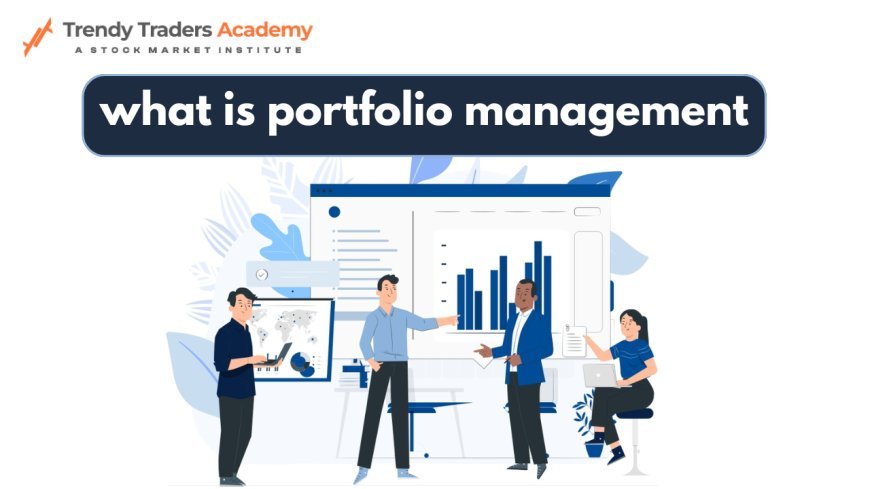What is Portfolio Management? Simple Guide for Everyone

What is Portfolio Management? A Beginner’s Guide for Everyone
Ever thought managing your money was a bit like gardening? You plant different seeds—stocks, mutual funds, bonds—and hope they grow. But without care, things can get messy. That’s where portfolio management comes in. Think of it as your financial gardening toolset—it helps you grow, protect, and organize your investments wisely.
And in today’s tech-savvy world, tools like algorithmic trading software and algo trading software India are becoming part of that toolkit. But what does it all mean, and how do you even get started?
Discover what portfolio management means in simple terms. Learn how algorithmic trading software & algo trading software India are changing the game.
Understanding Portfolio Management
Portfolio management is the art and science of making decisions about your money—where to invest, how much, and for how long. Think of it as organizing your wardrobe. You don’t want all jackets or all shoes. You need a mix, just like with investments.
A portfolio includes all your financial assets like stocks, bonds, real estate, gold, and even cryptocurrency.
Why Does Portfolio Management Matter?
Ever heard the phrase “don’t put all your eggs in one basket”? If one basket falls, you lose everything. Portfolio management helps balance your risks and rewards. It ensures that if one investment doesn’t perform well, others might cover for it.
It’s not just for the wealthy. Anyone with a savings account, SIP, or even a small investment in stocks can benefit.
Types of Portfolio Management
There’s no one-size-fits-all. Here are the main types:
-
Discretionary Portfolio Management: A professional makes all decisions for you.
-
Non-Discretionary: You get advice, but you make the final calls.
-
Passive Management: No frequent buying/selling. You invest and hold.
-
Active Management: Constant monitoring and adjusting.
Each has its pros and cons based on your goals and risk tolerance.
Active vs Passive Portfolio Management
Active Management is like having a personal trainer who constantly tweaks your workout. The aim is to beat the market.
Passive Management, on the other hand, is like doing yoga regularly—it’s consistent and less stressful. The goal here is to match the market, not beat it.
Which one’s better? That depends on your comfort with risk and how hands-on you want to be.
Key Elements of a Good Portfolio
To build a solid portfolio, you need:
-
Asset Allocation: Mix of asset types (stocks, bonds, etc.)
-
Diversification: Spreading investments to reduce risk.
-
Rebalancing: Adjusting your portfolio to stay on track with your goals.
-
Performance Review: Regular check-ins to see how you're doing.
Think of it like cooking—use the right ingredients, in the right amount, and taste often!
Risk Management in Portfolios
Every investment carries risk. Some are like spicy food—exciting but not for everyone.
Managing risk means understanding:
-
Market Risks (price fluctuations)
-
Credit Risks (borrower defaults)
-
Liquidity Risks (can't sell quickly)
The trick is not to avoid risk but to balance it smartly.
The Role of Diversification
If you invest only in tech stocks and they crash, your whole portfolio suffers. That’s where diversification comes in—mixing different assets so no single failure can drag you down.
It’s like building a cricket team—you need batsmen, bowlers, and fielders, not just star players.
Tools Used in Portfolio Management
Modern investors use various tools:
-
Spreadsheets for tracking.
-
Robo-advisors for automation.
-
Trading platforms for buying/selling.
-
Analytics software for insights.
But perhaps the biggest game-changer is...
What is Algorithmic Trading Software?
Imagine a robot that buys and sells stocks for you—based on logic, data, and no emotions. That’s algorithmic trading software.
It uses pre-set rules and algorithms to trade at high speeds and accuracy. Great for reducing human error and grabbing opportunities instantly.
Even beginners are exploring it thanks to user-friendly platforms.
How Algo Trading Software India Is Gaining Popularity
In India, algo trading is becoming huge, especially with the rise of platforms offering easy access and low brokerage. Companies like Zerodha, Upstox, and Angel One are leading the way.
The best part? You don’t need to be a techie. Many platforms now offer drag-and-drop strategies and templates.
If you’re in India and interested in modern investing, exploring algo trading software India could be a smart move.
Steps to Start Managing Your Own Portfolio
Here’s a step-by-step for beginners:
-
Set Clear Goals: Retirement, buying a home, education, etc.
-
Assess Risk Tolerance: Are you okay with ups and downs?
-
Choose Investment Types: Based on your goals and comfort.
-
Start Small: Don’t jump in with everything at once.
-
Track & Rebalance: Review regularly, adjust as needed.
-
Use Tools: Try out basic algorithmic trading software.
Common Mistakes to Avoid
-
Chasing Trends: What worked yesterday may flop today.
-
Ignoring Fees: Hidden charges can eat into returns.
-
Lack of Patience: Investments take time to grow.
-
No Rebalancing: Letting your portfolio drift off-track.
Learn from others’ mistakes and stay informed.
Should You Do It Yourself or Hire a Professional?
If you enjoy learning and have time, managing your own portfolio can be rewarding.
But if you’re too busy or unsure, a financial advisor or a robo-advisor might be worth it. Some investors even do both—DIY for some parts, and professional help for others.
How to Use Technology to Your Advantage
Thanks to tech, investing isn't just for the Wall Street elite anymore. Here’s how you can leverage it:
-
Mobile apps for instant trading.
-
Algo trading software to automate tasks.
-
News alerts to stay updated.
-
Online courses to build your knowledge.
It’s like having a financial assistant in your pocket.
Future of Portfolio Management
The future is digital and data-driven. AI, machine learning, and algorithmic trading software are expected to take portfolio management to the next level.
In India, regulatory changes and tech-friendly platforms are opening doors for retail investors like never before.
So, whether you're a student saving pocket money or a working professional eyeing early retirement, portfolio management is a skill worth learning.
Conclusion
At the end of the day, portfolio management is about taking control of your financial future. It’s not about getting rich overnight—it’s about building wealth steadily, smartly, and safely.
With tools like algorithmic trading software and the rising popularity of algo trading software India, the process is becoming more accessible to everyone.
Don’t wait for a “perfect time” to start. Like planting a tree, the best time was years ago. The second-best time? Today.
FAQs
What is the main goal of portfolio management?
The main goal is to maximize returns while managing risk through a balanced investment strategy.
Is portfolio management only for the rich?
Not at all. Anyone with savings or investments can—and should—manage their portfolio.
How does algorithmic trading software help in portfolio management?
It automates trading based on logic, helping reduce emotional decisions and improve efficiency.
Is algo trading legal in India?
Yes, it's legal and regulated by SEBI. Many platforms offer legal and compliant algo trading software in India.
Can I start portfolio management without a financial advisor?
Absolutely. With the right tools and a bit of learning, you can begin managing your own portfolio confidently.
What's Your Reaction?



























































